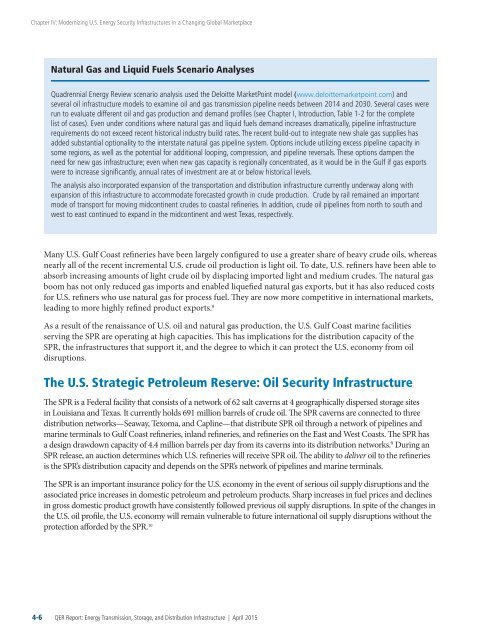LVXXU
LVXXU
LVXXU
Create successful ePaper yourself
Turn your PDF publications into a flip-book with our unique Google optimized e-Paper software.
Chapter IV: Modernizing U.S. Energy Security Infrastructures in a Changing Global Marketplace<br />
Natural Gas and Liquid Fuels Scenario Analyses<br />
Quadrennial Energy Review scenario analysis used the Deloitte MarketPoint model (www.deloittemarketpoint.com) and<br />
several oil infrastructure models to examine oil and gas transmission pipeline needs between 2014 and 2030. Several cases were<br />
run to evaluate different oil and gas production and demand profiles (see Chapter I, Introduction, Table 1-2 for the complete<br />
list of cases). Even under conditions where natural gas and liquid fuels demand increases dramatically, pipeline infrastructure<br />
requirements do not exceed recent historical industry build rates. The recent build-out to integrate new shale gas supplies has<br />
added substantial optionality to the interstate natural gas pipeline system. Options include utilizing excess pipeline capacity in<br />
some regions, as well as the potential for additional looping, compression, and pipeline reversals. These options dampen the<br />
need for new gas infrastructure; even when new gas capacity is regionally concentrated, as it would be in the Gulf if gas exports<br />
were to increase significantly, annual rates of investment are at or below historical levels.<br />
The analysis also incorporated expansion of the transportation and distribution infrastructure currently underway along with<br />
expansion of this infrastructure to accommodate forecasted growth in crude production. Crude by rail remained an important<br />
mode of transport for moving midcontinent crudes to coastal refineries. In addition, crude oil pipelines from north to south and<br />
west to east continued to expand in the midcontinent and west Texas, respectively.<br />
Many U.S. Gulf Coast refineries have been largely configured to use a greater share of heavy crude oils, whereas<br />
nearly all of the recent incremental U.S. crude oil production is light oil. To date, U.S. refiners have been able to<br />
absorb increasing amounts of light crude oil by displacing imported light and medium crudes. The natural gas<br />
boom has not only reduced gas imports and enabled liquefied natural gas exports, but it has also reduced costs<br />
for U.S. refiners who use natural gas for process fuel. They are now more competitive in international markets,<br />
leading to more highly refined product exports. 8<br />
As a result of the renaissance of U.S. oil and natural gas production, the U.S. Gulf Coast marine facilities<br />
serving the SPR are operating at high capacities. This has implications for the distribution capacity of the<br />
SPR, the infrastructures that support it, and the degree to which it can protect the U.S. economy from oil<br />
disruptions.<br />
The U.S. Strategic Petroleum Reserve: Oil Security Infrastructure<br />
The SPR is a Federal facility that consists of a network of 62 salt caverns at 4 geographically dispersed storage sites<br />
in Louisiana and Texas. It currently holds 691 million barrels of crude oil. The SPR caverns are connected to three<br />
distribution networks—Seaway, Texoma, and Capline—that distribute SPR oil through a network of pipelines and<br />
marine terminals to Gulf Coast refineries, inland refineries, and refineries on the East and West Coasts. The SPR has<br />
a design drawdown capacity of 4.4 million barrels per day from its caverns into its distribution networks. 9 During an<br />
SPR release, an auction determines which U.S. refineries will receive SPR oil. The ability to deliver oil to the refineries<br />
is the SPR’s distribution capacity and depends on the SPR’s network of pipelines and marine terminals.<br />
The SPR is an important insurance policy for the U.S. economy in the event of serious oil supply disruptions and the<br />
associated price increases in domestic petroleum and petroleum products. Sharp increases in fuel prices and declines<br />
in gross domestic product growth have consistently followed previous oil supply disruptions. In spite of the changes in<br />
the U.S. oil profile, the U.S. economy will remain vulnerable to future international oil supply disruptions without the<br />
protection afforded by the SPR. 10<br />
4-6 QER Report: Energy Transmission, Storage, and Distribution Infrastructure | April 2015


